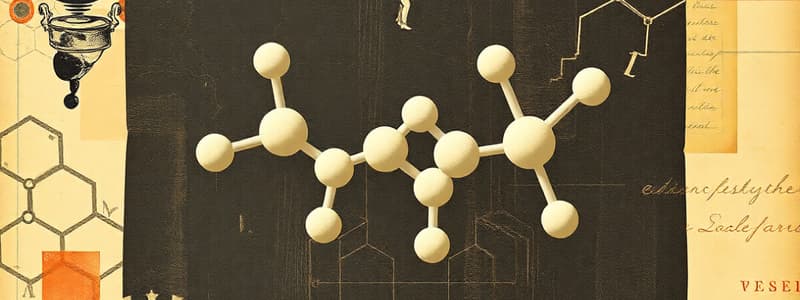Podcast
Questions and Answers
What defines a dextrorotatory compound?
What defines a dextrorotatory compound?
- A compound that rotates light counterclockwise
- A chiral compound that rotates light clockwise (correct)
- A compound that has no optical activity
- A compound that does not rotate light
Which of the following statements about enantiomers is true?
Which of the following statements about enantiomers is true?
- Enantiomers can have significantly different biological effects. (correct)
- Enantiomers have the same interactions with all chiral molecules.
- Enantiomers react similarly with achiral solvents.
- Enantiomers can have different boiling points but the same melting points.
How do enantiomers differ in terms of solubility?
How do enantiomers differ in terms of solubility?
- Enantiomers have the same solubility in chiral solvents.
- Enantiomers have different solubility in all solvents.
- Enantiomers have the same solubility in achiral solvents. (correct)
- Enantiomers have different solubility only in polar solvents.
Which factor does not affect the boiling point, melting point, or density of enantiomers?
Which factor does not affect the boiling point, melting point, or density of enantiomers?
What is the relationship between + and - designations and D and L designations?
What is the relationship between + and - designations and D and L designations?
What distinguishes the α-form of D-Glucose from the β-form?
What distinguishes the α-form of D-Glucose from the β-form?
What would happen if two chiral molecules were to interact with each other?
What would happen if two chiral molecules were to interact with each other?
What are anomers?
What are anomers?
Which statement about the rotational properties of enantiomers is accurate?
Which statement about the rotational properties of enantiomers is accurate?
Which of the following monosaccharides is likely to form cyclic structures similar to D-Glucose?
Which of the following monosaccharides is likely to form cyclic structures similar to D-Glucose?
In what way could the body respond differently to enantiomers?
In what way could the body respond differently to enantiomers?
What is the difference between pyranose and furanose?
What is the difference between pyranose and furanose?
Which statement is true regarding the cyclic forms of monosaccharides?
Which statement is true regarding the cyclic forms of monosaccharides?
What aspect of cyclic monosaccharides varies among aldoses with five or more carbon atoms?
What aspect of cyclic monosaccharides varies among aldoses with five or more carbon atoms?
Which property is characteristic of glucose's cyclic forms?
Which property is characteristic of glucose's cyclic forms?
Why are cyclic forms of monosaccharides important in biochemistry?
Why are cyclic forms of monosaccharides important in biochemistry?
What is a defining characteristic of enantiomers?
What is a defining characteristic of enantiomers?
Which monosaccharide classification corresponds to a sugar with six carbon atoms and one aldehyde group?
Which monosaccharide classification corresponds to a sugar with six carbon atoms and one aldehyde group?
Which of the following is NOT a property of diastereomers?
Which of the following is NOT a property of diastereomers?
What is the common name for D-Glucose?
What is the common name for D-Glucose?
What results from the replacement of a hydroxyl group with an amino group in a monosaccharide?
What results from the replacement of a hydroxyl group with an amino group in a monosaccharide?
Which of the following typically has the highest percentage of glucose by mass?
Which of the following typically has the highest percentage of glucose by mass?
Which hydroxyl group is typically replaced by an amino group in naturally occurring amino sugars?
Which hydroxyl group is typically replaced by an amino group in naturally occurring amino sugars?
Which of the following best describes a ketopentose?
Which of the following best describes a ketopentose?
Which of these is a type of sugar produced from grape and ripe fruits that is significant for human nutrition?
Which of these is a type of sugar produced from grape and ripe fruits that is significant for human nutrition?
What type of linkage is formed between two monosaccharides in a disaccharide?
What type of linkage is formed between two monosaccharides in a disaccharide?
Which two monosaccharides create maltose?
Which two monosaccharides create maltose?
What distinguishes aldoses from ketoses?
What distinguishes aldoses from ketoses?
What type of glycosidic linkage is found in maltose?
What type of glycosidic linkage is found in maltose?
Why is maltose easily digested by humans?
Why is maltose easily digested by humans?
Which statement correctly describes the formation of disaccharides?
Which statement correctly describes the formation of disaccharides?
Which of the following is NOT derived from amino sugars?
Which of the following is NOT derived from amino sugars?
What is the primary function of cellulose in the diet?
What is the primary function of cellulose in the diet?
What type of glycosidic linkages are present in chitin?
What type of glycosidic linkages are present in chitin?
Which of the following is an example of an acidic polysaccharide?
Which of the following is an example of an acidic polysaccharide?
What is the role of hyaluronic acid in the body?
What is the role of hyaluronic acid in the body?
What distinguishes acidic polysaccharides from other polysaccharides?
What distinguishes acidic polysaccharides from other polysaccharides?
Which of the following best describes the structural similarity between cellulose and chitin?
Which of the following best describes the structural similarity between cellulose and chitin?
What type of sugar is involved in the composition of heparin?
What type of sugar is involved in the composition of heparin?
How many disaccharide residues can be found in a chain of heparin?
How many disaccharide residues can be found in a chain of heparin?
Flashcards
α-form of glucose
α-form of glucose
Cyclic form of glucose where the -OH group on carbon 1 and the CH2OH group on carbon 5 are on opposite sides.
β-form of glucose
β-form of glucose
Cyclic form of glucose where the -OH group on carbon 1 and the CH2OH group on carbon 5 are on the same side.
Anomer
Anomer
Cyclic monosaccharides that differ only in the position of the substituents on the anomeric carbon atom.
Pyranose
Pyranose
Signup and view all the flashcards
Furanose
Furanose
Signup and view all the flashcards
Enantiomer
Enantiomer
Signup and view all the flashcards
Dextrorotatory
Dextrorotatory
Signup and view all the flashcards
Levorotatory
Levorotatory
Signup and view all the flashcards
Monosaccharide
Monosaccharide
Signup and view all the flashcards
Triose
Triose
Signup and view all the flashcards
Tetrose
Tetrose
Signup and view all the flashcards
Pentose
Pentose
Signup and view all the flashcards
Hexose
Hexose
Signup and view all the flashcards
Aldose
Aldose
Signup and view all the flashcards
Ketose
Ketose
Signup and view all the flashcards
Glucose
Glucose
Signup and view all the flashcards
Glycosidic linkage
Glycosidic linkage
Signup and view all the flashcards
Maltose
Maltose
Signup and view all the flashcards
Cellulose
Cellulose
Signup and view all the flashcards
Chitin
Chitin
Signup and view all the flashcards
Hyaluronic acid
Hyaluronic acid
Signup and view all the flashcards
Heparin
Heparin
Signup and view all the flashcards
Amino sugar
Amino sugar
Signup and view all the flashcards
Study Notes
Cyclic Forms of Monosaccharides
- D-Glucose has two forms: α-form and β-form.
- The α-form has the –OH group of carbon 1 and the CH2OH group of carbon 5 on opposite sides.
- The β-form has the –OH group of carbon 1 and the CH2OH group of carbon 5 on the same side.
- Anomers are cyclic monosaccharides that differ only in the position of the substituents on the anomeric carbon atom.
- Aldoses with 5 or more carbon atoms establish similar equilibria like D-glucose, but with different percentages of alpha, beta, and open-chain forms.
- Fructose and other ketoses with sufficient carbon atoms also cyclize.
- Pyranose is a cyclic monosaccharide containing a six-atom ring.
- Furanose is a cyclic monosaccharide containing a five-atom ring.
Properties of Enantiomers
- Enantiomers are optically active.
- Dextrorotatory compounds rotate the plane of polarized light clockwise.
- Levorotatory compounds rotate the plane of polarized light counterclockwise.
- There is no correlation between D, L, and +, -.
- Enantiomers react differently with other chiral molecules.
- Enantiomers have the same solubility in achiral solvents but different solubility in chiral solvents.
- Enantiomers have the same boiling points, melting points, and densities.
- Diastereoisomers have different physical and chemical properties, while enantiomers have the same physical and chemical properties.
Classification of Monosaccharides
- Monosaccharides are classified based on the number of carbon atoms and functional groups.
- Triose has 3 carbons, tetrose has 4 carbons, pentoses have 5 carbons, and hexoses have 6 carbons.
- Aldoses have one aldehyde group.
- Ketoses have one ketone group.
Biochemically Important Monosaccharides
- Glucose is the most abundant monosaccharide in nature.
- Glucose is the most important source of human nutrition.
- Glucose is also known as grape sugar or dextrose.
- Blood sugar levels range from 70–100 mg/dL.
Reactions of Monosaccharides
- Amino sugars are formed when one of the hydroxyl groups of a monosaccharide is replaced with an amino group.
- The C2 hydroxyl group is replaced by an amino group in naturally occurring amino sugars.
- Amino sugars are important building blocks of polysaccharides such as chitin and hyaluronic acid.
Disaccharides
- Two monosaccharides can react to form a disaccharide.
- The ether bond formed is a glycosidic linkage.
- Maltose (malt sugar) is composed of two D-glucose units linked via an α(1→4) glycosidic linkage.
- Humans can digest maltose easily because of an enzyme that can break α(1→4) linkages.
Structural Polysaccharides
- Cellulose is a linear polymer of D-glucose units linked via β(1→4) glycosidic linkages.
- Cellulose is found in plant cell walls and is important for structural support.
- Chitin is a linear polymer with all β(1→4) glycosidic linkages.
- Chitin has an N-acetyl amino derivative of glucose.
- Chitin gives rigidity to the exoskeletons of arthropods such as crabs, lobsters, shrimp, and insects.
Acidic Polysaccharides
- Acidic polysaccharides are polysaccharides containing a repeating disaccharide unit with an amino sugar and a sugar with a negative charge due to a sulfate or carboxyl group.
- Acidic polysaccharides are heteropolysaccharides, meaning they contain different monosaccharides in an alternating pattern.
- Hyaluronic acid is a highly viscous acidic polysaccharide that acts as a lubricant in joints and the vitreous humor of the eye.
- Heparin is an acidic polysaccharide that acts as a blood anticoagulant.
Studying That Suits You
Use AI to generate personalized quizzes and flashcards to suit your learning preferences.




